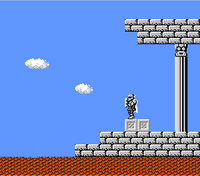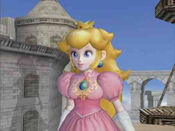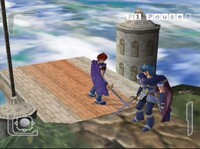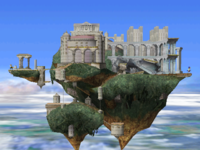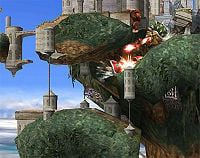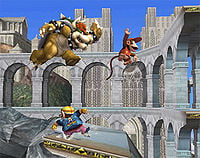Temple
| Temple | |
|---|---|
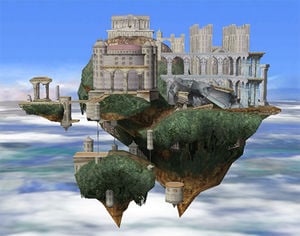 File:ZeldaSymbol.png | |
| Universe | The Legend of Zelda |
| Appears in | SSBM SSBB |
| Availability | Starter (SSBM and SSBB) |
| Crate type | Normal |
| Tracks available | In Melee: Temple Fire Emblem (Alternate) In Brawl: Temple (Melee) Great Temple / Temple Bolded track must be unlocked |
| Article on Zelda Wiki | Dungeons in Zelda II: The Adventure of Link |
Announced at E3 2001, Temple (神殿 Shinden) is a stage that appears in Super Smash Bros. Melee, also appearing as a returning stage in Super Smash Bros. Brawl as one of the Melee Stages. It is commonly known as Hyrule Temple (this name appears in Melee's instruction booklet at page 49), though its proper name is Temple (since "Hyrule" denotes Temple's location).
Stage Description
Temple is one of the eighteen default stages available in Super Smash Bros. Melee. It is a Legend of Zelda stage on which characters from that franchise (along with the characters from the Fire Emblem franchise) will usually battle the player in the single player modes. The layout is based on the palaces from Zelda II: The Adventure of Link.
In Melee's All-Star mode, this stage is played on when Zelda and her teammates are fought. It is also where Zelda will fight in Classic Mode and will sometimes play the song "Lost Woods" which is Zelda's credits song. In Super Smash Bros. Brawl the stage no longer has a chance of playing the "Fire Emblem" medley theme from Melee, because the track has moved to the Fire Emblem-themed Castle Siege stage. A remix of the "The Great Temple" theme from Zelda II: The Adventure of Link can be obtained to play on this stage in My Music, making it the only Melee stage that has a new piece of music available to play on it. In Brawl, the ledge on the right hand side can no longer be grabbed on the larger bottom platform as it could in Melee.
Fight Club
The underground area on the stage is referred to by Nintendo Power as the "Fight Club". It is termed so because battles there tend to produce disproportionately high damage totals, due to the fact that the surrounding environment has walls on all sides that can be teched off of, which keeps characters from leaving the stage and greatly increasing the difficulty of KOing them. The ease in which a high damaged character can survive in the Fight Club can often lead to players turtling inside. The area is also known by a variety of other nicknames by players.
Tournament Legality
As an extremely large stage, it is banned in all serious tournaments because its size and build provides opportunities for game-breaking camping and stalling. The many walls allow for wall infinites ,and the underground section creates a large cave of life, allowing characters to live to extremely high damages that are impossible to reach in normal conditions.
Temple is a stage that is often considered among newer players to be a balanced and fair stage simply because it lacks hazards and has interesting geometry. However, most competitive players will attest that Temple is among the most unfair and least balanced stages in the game. Most of the misconceptions about its fairness come from newer players who see the large size as a way to allow them to live longer. While this is true to a degree, the upper blast line is much closer to the stage in more places than the horizontal blast lines are. This gives a distinct advantage to characters whose most effective KO moves produce vertical knockback (such as Fox), but hinders a character whose most effective KO moves produce horizontal knockback (such as Captain Falcon).
When the above is taken into consideration, Temple is banned in tournaments because it gives unbeatable advantages to certain characters (most notoriously Fox), forces the game to be played in a drastically different way from other stages, and would lead to much longer matches that would often go to time.
Hyrule Jump
- See Hyrule Jump for more information.
Due to its immense size and its structure, Temple is a stage where notable feats involving the traversing of large area are performable, such as the Hyrule Jump and, as of Brawl, gliding completely around the stage.
Origin
This stage is from Zelda II: The Adventure of Link. In The Legend of Zelda: Ocarina of Time, the name of the dungeons is based off of the type of environment around it or the location with "Temple" at the end. However, in Zelda II, these dungeons are called "Palaces". Hyrule is where the Temple is located, hence Hyrule Temple. In Zelda II every palace begins with two high steps with a statue standing on the top platform. There are also some columns on the floor that hold the ceiling up. Shortly after going past the columns is an elevator that takes the player down to the level below. This stage features a rounded platform on the left and there are also columns that holds a platform up, with a route that goes down to the level below. However, there is no elevator going down to the area below. The palaces in Zelda II are notorious for their many levels and the length of the levels themselves. This stage being by far the largest stage in Melee is similar to the immense size of Zelda II's palaces. In the overworld map of Zelda II there is an icon that represents the palaces. The icon is a building supported by columns. In the far background of this stage can be seen a small building that is supported by columns. The platforms on this stage has Hylian writing that looks similar to the writing posted on signs in Ocarina of Time. [1]
There are two music tracks that can be heard on this stage in Melee. The first tracks comes from Zelda II: The Adventure of Link when the player is in a palace. The alternate music is a mix of "Recruiting a New Member" theme and the title screen of Fire Emblem: Shadow Dragon and the Blade of Light. [2]
Brawl also added a new tracks for this stage in My Music, being a remix of the Palace and Great Palace themes from Zelda II, under the name Great Temple / Temple.
Temple Race
Temple Race is a method of gameplay in Super Smash Bros. Melee that could be considered as a Special Melee, though it must be set up through manual means. The mode features no specific data within Melee, but gameplay of the mode is explained in the instruction booklet. The mode would only be possible with human players, as there are no CPU commands to co-operate with this type of Melee.
How to Play
The suggested way to play Temple Race is to first set up a timed match on the Temple stage, with any time limit being allowed. The players must then choose the layout of a course, some of which may require usage of the Hyrule Jump, and then the player that can complete most laps of this chosen layout within the designated time limit is declared the winner.
Description in the Instruction Booklet
Play a MELEE battle in Time Mode. Set the time and choose the HYRULE TEMPLE stage. Choose a particular route, then see who can complete the most laps within the time limit.
Trivia
- In Melee, if Sheik's Chain is used in the correct spot in the tunnel of Temple, the tip of the chain will stick to the roof of the tunnel and make a straight line from her hand to the roof. This is sometimes referred to as the Sticky Chain glitch. In Brawl, there is another glitch involving Sheik's Chain when used in the right position on the stone slab to the right of the entrance to the underground area. If performed correctly, the chain makes a high pitched sound that is different from the usual sound produced.
- In Melee, Temple is notorious for exploiting the flawed AI. One such example is if Jigglypuff and Kirby are knocked off the left side of the lower part of the stage, they will attempt to return using their multiple midair jumps, but will sometimes get stuck on the slight overhang above. This is usually not fatal to Jigglypuff, as it will often glide back to the platform after its jumps are exhausted, but Kirby will use his Final Cutter and fall straight down for a SD. Another notable example is where Fox as a level 9 CPU cannot escape from the lower area of the stage if the player is on the top area, as it will attempt to jump on the path leading to the top but fail, walk side to side on the bottom, fall off the right side, use Fire Fox to get back up, and repeat. With the improved AI, these specific CPU exploits do not occur in Brawl.
- In the "Special Video" of Melee, during two clips of Temple, two odd platforms can be seen, which do not appear on the stage in Melee or Brawl. The same platforms can be seen in the short video clip after beating a single player mode as Luigi as well as in the manual's picture depicting Fixed-Camera Mode.
- Along with the platforms, early versions of the game featured an elevator to lead to the bottom of the stage; this does not appear in the finished form of the game.
- If Pokémon Trainer is chosen, he stands on top of the arches in the middle section of the stage.
- If Sonic releases his Spin Dash while facing right on the stairs to the left of the large floating platform, he will shoot horizontally across the stage, going over any gaps, ignoring gravity, and self destruct.
- This is the only Melee stage in Brawl that has at least one track that isn't from Melee.
Gallery
| Stages in Super Smash Bros. Melee | |
|---|---|
| Starter stages | Brinstar · Corneria · Fountain of Dreams · Great Bay · Green Greens · Icicle Mountain · Jungle Japes · Kongo Jungle · Mushroom Kingdom · Mute City · Onett · Pokémon Stadium · Princess Peach's Castle · Rainbow Cruise · Temple · Venom · Yoshi's Island · Yoshi's Story |
| Unlockable stages | Battlefield · Big Blue · Brinstar Depths · Final Destination · Flat Zone · Fourside · Mushroom Kingdom II · Poké Floats |
| Dream Land · Kongo Jungle · Yoshi's Island | |
